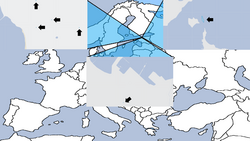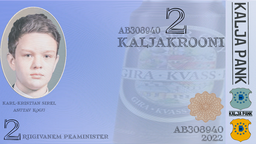Estonian Republic of Kali
Estonian Republic of Kali Eesti Kaljavabariik | |
|---|---|
| Motto: "Joo kalja" "Drink Kali" | |
| Anthem: "Long live, Kalia" | |
 Territories of the Estonian Republic of Kali | |
| Status | Active |
| Capital | Kumbli |
| Largest city | Kõivu |
| Official languages | Estonian |
| Ethnic groups (2023) | 100% Estonian |
| Religion (2023) | 100% No religion |
| Demonym(s) | Kalian |
| Government | Unitary Kertsist Presidential Semi-Parliamentary Republic under an Authoritarian Dictatorship |
• State Elder | Koit Tamme |
| Legislature | People's Council |
| Upper People's Council | |
| Lower People's Council | |
| Independence from Estonia | |
• Independence | 22 April 2022 |
• Constitution ratified | 2 May 2022 |
| Area | |
• Total | 0.023 km2 (0.0089 sq mi) |
| Population | |
• 2023 census | 11 |
| Currency | Kaljakroon (de jure), Euro (de facto). |
| Time zone | EST (GMT3+) |
• Summer (DST) | UTC+3 |
| Date format | dd/mm/yyyy |
| Driving side | right side |
| Calling code | 372+ |
Republic of Kali, more commonly known as Kalia (Estonian: Kaljavabariik or Kaljamaa) and officially the Estonian Republic of Kali (Estonian: Eesti Kaljavabariik) is a self-proclaimed Landlocked Micronation located on the Viimsi peninsula in Tallinn, Estonia.
The Estonian Republic of Kali was to be declared an independent and sovereign nation on the 22 April 2022, but the process of declaring independence was incomplete and the state was declared on 2 May instead (though, 22 April is still considered the day the country became independent) by the Constituent Assembly. From there on, several reformation eras have taken place, as well as the Uti Question that almost led the country to war.
The Estonian Republic of Kali is a Unitary Presidential Semi-Parliamentary Kertsist Republic where the highest legal authority is the State Elder.
Kalia was a former neutral country, having no diplomatic relations with other countries at all. The neutrality began slowly fading after the Estonian Republic of Kali was accepted into the Baltic Union and it was completely disbanded after the constitutional crisis.
Etymology
Originally, the name "Estonian Republic of Beer" was chosen for the same reason the Republic was founded, a member of our country accidentally ate an alcohol-consisting fruit. The name would change after the second declaration of independence to the "Estonian Republic of Kali" named after a national non-alcoholic drink in Estonia that the members of the Republic like to drink.
Official Names
- 22 April 2022-2 May 2022: Estonian Republic of Beer (EÕV)
- 2 May 2022-present: Estonian Republic of Kali (ERK)
History
Declaration of Independence
Kalian history began with the accidental consumption of an alcoholic orange by one of the members of Constituent Assembly, leading to the declaration of independence on April 22. The Independence Manifesto established the Estonian Republic of Beer on Kõivu Põik and Palderjani Tee. The declaration was initially informal but was formalized on May 2nd.
The Republic of Beer
First Republic of Beer
The informal and ill-prepared government of the Estonian Republic of Beer consisted of only 3 people. No formalization of the government or election of the State Elder took place, and no constitution or laws were established. This era is remembered as the "Dark era" of the state.
Second Republic of Beer
After a new declaration of independence on May 2, 2022, the "Second Republic" of the Estonian Republic of Beer was founded. The country declared on April 22 legally remained the same, but elections for the State Elder were held, a constitution was written, and a governing system was established. The President-Dictator later renamed the nation to the Estonian Republic of Kali, marking the end of the Republic of Beer era.
Kalia today

2022
The president of Kalia sought to expand the state and to incorporate the Hõbekuuse Tee region. Despite initial uncertainty, an ultimatum was issued and war preparations began. Fortunately, the region chose to join voluntarily, preventing conflict.
Era of Great Reformation
After the Uti Question, the Republic's population grew to 6 citizens. The State Elder initiated the Era of Great Reformation on August 31, 2022. Reforms included dissolving the Deciding Council, establishing the Council of Ministers and People's Council, adopting the Kalja Kroon currency, rewriting the National Anthem, introducing a new flag, and formalizing the borders. The era concluded on September 3rd.
Constitutional Crisis
On September 20, 2022, a Constitutional Crisis began in the Estonian Republic of Kali. Justice-, Internal-, and Foreign Minister Koit Tamme discovered that State Elder Kert Tamme had violated §4 of the Kalian constitution, invoking §5 and forcing the State Elder to abdicate. This left the country without a ruler, and it was revealed during a debate that the constitution contained several illogical paragraphs. The Justice minister declared an emergency situation, invalidating the current constitution until further discussion. Elections and actions were suspended, freezing the country until a resolution could be reached.
A meeting with the People's Council was held, resolving the crisis and electing Koit Tamme as the new State Elder. The constitution was reformed and new ministers were appointed to address the crisis.
Neutrality fading
On 15 September 2022, a member of Kalia submitted a proposal to the People's Council to join the Baltic Union. The vote was passed and on the 19th the country was de jure accepted into the union. From there on the country's neutrality began to fade. A week prior, the former State Elder of the country illegally changed the constitution establishing full neutrality in the country which led to the constitutional crisis, leading to a new State Elder being elected . The new State Elder would finally abolish the neutrality and begin building up relations with other micronations.
Estonian Cold War
Nine-Hour Conflict (First phase)
The Nine-Hour Conflict began on November 5 at 12.19 o'clock when Kalian foreign minister Kert Tamme engaged in non-official talks with the ESR. Due to a misunderstanding, the conversation turned to the topic of war, resulting in a nine-hour conflict between Kalia and Estonian Socialist Republic. The conflict was resolved when State Elder Koit Tamme proposed a peace treaty, which was accepted by ESR, marking the end of the conflict.
Second phase
The conflict reignited on November 6 when the first secretary of Estonian Socialist Republic announced another mobilization against Kalia. Despite a previous peace treaty, ESR refused to end the conflict, leading to tension and diplomatic exchanges. Eventually, a peace offer from Kalia was accepted, avoiding further escalation.
Third phase
Tensions resurfaced a week later on November 14, with the Estonian Socialist Republic provoking Kalia once again. Kalia considered declaring war and held emergency meetings. Eventually, a peace deal was reached, but ESR refused to sign the treaty, leading to modifications and an armistice agreement on November 21, ending the cold war.
Government
Overview
The Kalia Republic is a Unitary Presidential Semi-Parliamentary Kertsist Republic where the highest legal authority is the State Elder. Decisions are put on a vote by the State Elder which the People's Council must vote on. If no decision is reached, the vote passes on to the Council of Ministers. If a decision is reached, the prime minister and a proper minister must sign the decision. After that, the State Elder announces the decision and then it is in effect.
Law and order
The law of the state is managed by the Justice Minister and the State Elder
The law of the Kalia Republic is based on the constitution of Kalia which consists of two chapters and 13 points.
Foreign Relations
The Estonian Republic of Kali had a foreign Policy of neutrality, however, after the constitutional crisis, the neutrality was completely abolished. Since then the country has begun building up diplomatic relations with other micronations and on 1 October 2022 Kalia was officially accepted into the Baltic Union. Kalia Republic has also begun building up close relations with the Great Kingdom of Slitronia. On October 25 a mutual recognition treaty was signed which basically serves as an alliance treaty, bringing the two states even closer.
Administrative Divisions
The Estonian Republic of Kali consists of 5 administrative divisions.
| Flag | Name | Population | |||
|---|---|---|---|---|---|
| Administrative Divisons | |||||
 |
Kõivu Territory | 4 | |||
 |
Hõbekuuse Territory | 1 | |||
 |
Palderjani Territory | 1 | |||
 |
Ranniku Territory | 1 | |||
 |
Paluülase Territory | 1 | |||
 |
Kumbli Territory | 0 | |||
Military
Land forces
The Kalia Republic has a standing army, consisting of 2 battalions that make up the National Army of Kalia. It is mandatory for all of the citizens of Kalia to serve in the NAK. This helps the state to maintain a high manpower and a numerically big army for its size, currently consisting of 7 total personnel, with paramilitary and officers included.
The navy currently exists without any naval boats or vessels, making the navy currently inactive. Kalia has began planning the reformation of the navy during the summer of 2023, when the landing of Kumbli island is planned.
Culture and Media
Media
The Kalia Republic mainly keeps contact with its citizens via social media, mainly using their Discord Server for updates on the nation, meetings, votes etcetera. Kalia is also in the middle of creating another source of communication - the Kalian radio, allowing messages to be sent immideatly. Kalia also has a national Broadcasting service called the Kalian National Broadcasting Service [KRR] which operates the Kalian National Television , the official news website [1] and the radio.
Culture
National Holidays
National holidays in Kalia
| Date | Name | Description |
|---|---|---|
| 1 January | New Year's Day | The First day of a new year |
| 24 February | Estonian Independence Day | The Day Republic of Estonia declared
independence from Russia |
| 22 April | Kalian Independence Day | Day for celebrating the independence
of the Kalia Republic |
| 2 May | Constitution Day | Day to celebrate the ratification of the
constitution of the Kalia Republic |
| 23 June | Victory Day | Day to celebrate Estonian victory over the
Baltic Landeswehr and Iron Division |
| 24 June | Jaanipäev | Day to celebrate the beginning of the
summer period in Kalia |
| 24 December | Christmas Eve | Christmas eve |
| 25 December | First Christmas Day | Christmas |
| 26 December | Second Christmas Day | Christmas |
| 31 December | New Year's Eve | Last day of the old year |
National Drinks and Food
List of the National drinks and food of the Kalia Republic
| Drinks | Food |
|---|---|
| Kali | Verivorst |
| Beer | Sült |
| Tea | Rukkipala |
National symbols
The Flag of Kalia is a tricolour of black, blue and white with the coat of arms of Kalia in the middle of it. The flag was adopted on the 16 February 2023. Prior to the current flag, there have been four other flags mainly featuring the colours of blue, black and white.
The coat of arms of Kalia is a shield of golden colour and on top of it, there is a cup of kvass (kali) with 12 blue stars surrounding the shield which represent perfection and equality. The coat of arms was adopted on 16 February 2023.
The anthem of the Estonian Republic of Kali is "Long live Kalia". The anthem's melody was written by Enn Võrk and the lyrics were written by Koit Tamme. The anthem was adopted on the 24 October 2022.
Economy

The Kalian economy, though not very prosperous, has begun increasing. After the III People's Council was formed, the Kalian State Elder, prime minister and the minister of economy began heavily working on the build-up of the Kalian economy, laying down plans for its development by unofficially forming the Kalian Consumer Goods company, reforming the Kaljakroon as well as implementing the 4-month plan. Kalian economy mainly runs on tax collection.

